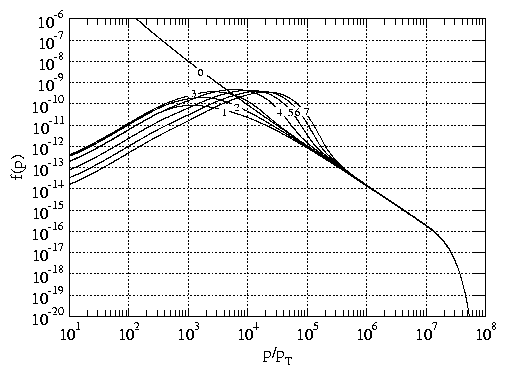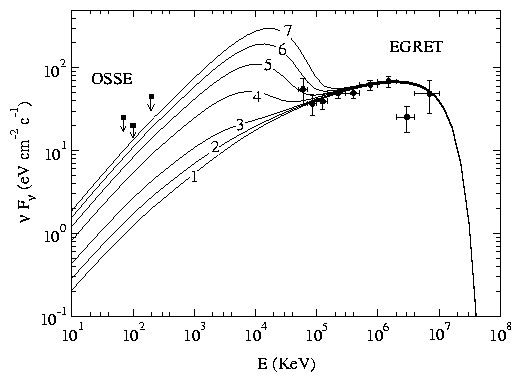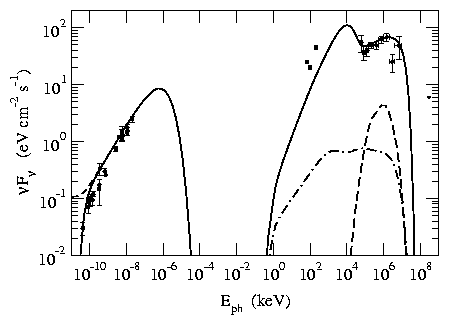High energy nonthermal radiation detected from some SNRs could be a direct evidence of an effective acceleration of protons and electrons up to an energies ~ 10 TeV in these remnants. Modeling of the nonthermal radiation is very important because it could give a valuable information about SNR and surrounding interstellar medium.
Based on kinetic model of an electron acceleration by collisionless shock waves we studied electron acceleration in the vicinity of a shell-type SNR with applications to IC 443 and RX J1713.7-3946. We calculated the radiation spectrum of the remnants in radio, X-ray and gamma energy ranges taking into account bremsstrahlung, synchrotron and inverse Compton radiation processes. We showed that the nonthermal radiation spectrum of IC 443 is consistent with just nonthermal electron emission in all the energy ranges. Our model also can describe the nonthermal emission from the shell type SNR RX J1713.7-3946.
We studied possible consequences of the second order Fermi acceleration of electrons on magneto-hydrodynamic (MHD) fluctuations in the shell. This acceleration produces a spatially inhomogeneous electron distribution function that differs from a pure power law distribution. In case of IC 443 this difference could result in a special spectral feature in the energy band ~ 10-100 MeV that can be detected by upcoming gamma-ray telescopes. Future observations in this energy range could provide an opportunity to study strength and spatial distribution of the MHD fluctuations in SNR IC 443.
Keywords: particle acceleration, nonthermal radiation, supernova remnants, IC 443, Cosmic Rays.It is assumed that supernova remnants are a most plausible candidates to the role of the galactic Cosmic Ray source. A possible confirmation of this hypothesis is the fact that a nonthermal radiation was detected from various SNRs. Among them there are remnants with emission spectrum that can be described as electron synchrotron radiation ([1] and others) and remnants which spectrum can't be described as pure synchrotron radiation. There were attempts to find a nucleon radiation component in the spectrum of such remnants ([2,3] and others). Finding of a nucleon component should be a direct evidence of the hypothesis that SNRs are really a source of galactic Cosmic Rays. But in all these attempts the possibility that emission spectrum has a an electron origin wasn't excluded for sure. Thats why a modeling of electron acceleration in SNRs is very important.
Shock waves generated during remnant expansion into the interstellar medium are effective particle accelerators due to a first order Fermi acceleration process. However in order to efficiently involve thermal electrons into Fermi acceleration an additional injection is needed. The process of injection was widely discussed in literature but the complete theory of it is not constructed yet.
To resolve the problem of electron injection we developed in paper [4] the kinetic model that describes a generation of the electron distribution function in the vicinity of a collisionless quasiperpendicular shock wave. The electron distribution function1 fe(p,z) (which is normalized to concentration n(z) as dn(z)=fe(p,z) ·p2 dp) in the stationary case must be a solution of the following kinetic equation that takes into account an electron diffusion in the coordinate and momentum spaces due to their scattering on magnetic field fluctuations produced by MHD turbulence, an electron convection in plasma flow and an electron energy looses:
 (1)
(1)
Index i in (1) describes a spatial region and is equal 1,2,3 for upstream, shock transition region and downstream. Function F(p)=[d p/d t](p) describes an electron energy looses. Diffusion coefficient in the momentum space Di(p)=ai [(u12)/(9 ki(p))] depends on a MHD turbulence spectrum. Dimensionless parameter ai ~ [(dui2)/(u12)] is a model parameter that describes an unknown spectrum of a MHD turbulence.
We applied our model to calculate nonthermal electron distribution and their emission for the well known SNR IC 443. A following processes have an influence on a formation of an electron distribution function in the downstream: first and second order Fermi acceleration, electron energy looses and their escaping from the system. In [5] we studied the generation of the electron distribution function taking into consideration first order Fermi acceleration, energy looses and electron escape. In this work we also include into consideration a second order Fermi acceleration which is important if MHD turbulence in the remnant is strong enough. We show that in this case a nonhomogeneous distribution function emerges in the remnant that differs from the pure power law distribution (fig.1). In the emission of IC 443 this difference could result in an excess of radiation in the energy band 10-100 MeV that can be detected by upcoming gamma-telescopes. On fig.1 we show our model electron distribution functions and bremsstrahlung radiation spectra calculated for SNR IC 443 in different assumptions on the MHD turbulence level in the remnant.


Figure 1: An electron distribution function on the distance X=6·1017 cm from the shock front (on the first graph) and a nonthermal electron bremsstrahlung radiation from the remnant (on the second graph) calculated for different parameters a3 in the shell. The curves {1,2,3,4,5,6,7} are calculated for parameter a3={0;5·10 -5;1·10 -4;2·10 -4;3·10 -4; 4·10 -4;5·10 -4}. The curve 0 shows the distribution function just after the shock. PT here is the thermal electron momentum for the temperature T=104 K. The data points of EGRET observations from the 3rd EGRET catalogue [6] (circles) and OSSE observations [7] (squares) are also shown.
On fig.2 we show the total spectrum of IC 443 calculated according to our model. In this calculation we used almost the same parameters as we used in [5] but we also took into account a possible second order Fermi acceleration in the shell where we described a MHD fluctuations by the parameter a3=3·10-4. We also show by the long dashed curve on fig.2 a possible emission due to secondary p0 decay. For this calculation we approximated a flux of nonthermal protons by a power law and considered it to be equal to the electron flux on relativistic energies. If we apply our model to SNR RX J1713.7-3946 assuming that the distance to it is also ~ 1.5 pc we obtain the similar shape of electron distribution function and emission spectrum.

Figure 2: Our model emission spectrum of IC 443. Solid curves show synchrotron and bremsstrahlung radiation. The inverse Compton radiation is shown by dash-dotted curve. Short dashed curve shows the synchrotron radiation without taking into account a free-free absorption. Possible radiation due to secondary p0 decay is shown by the long dashed curve. The data points of radio observations [8] (circles), EGRET observations from the 3rd EGRET catalogue [6] (rombs), OSSE observations [7] (squares) and WHIPPLE upper limit [9] (triangle) are also shown.
Using our model we studied the influence of the additional second order electron acceleration by MHD turbulence on the generation and evolution of the electron distribution function. We found that this acceleration could lead to substantial modification of the electron distribution function in the supernova remnant and such modification of the electron distribution function should lead to the excess in the remnant emission spectrum in the 10-100 MeV energy band that could be observed by the space telescope GLAST. So future GLAST observations of IC 443 will be very important. We also found that nonthermal spectrum of SNR IC 443 (and RX J1713.7-3946) can be explained as pure electron radiation spectrum, but a possibility of some addition to the remnant emission from nucleons can't be excluded.
Our work was supported by RFBR grants 03-02-17433 and 03-07-90200, president of the Russian Federation grant for young candidates of sciences 2642.2003.02, Russian science school grant 1115.2003.2.